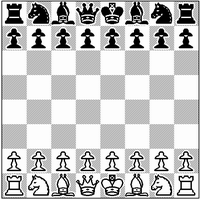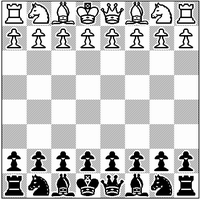
|
We have planned a bughouse chess tournament (rapid games, 5 minutes long) on Tuesday evening, 7th of September. The bughouse rules are on a separate page. An Introduction to Bughouse ChessBughouse (or Siamese) chess is a variation of chess played between two teams of two players, each on a separate board. This requires the two chessboards be placed side by side with partners sitting on the same side of the table. For each team, one player plays with white pieces and the other plays with black. |
Team B
Player 3 |
Team B
Player 4 |
||||||
 |
 |
||||||
Team A Player 1 |
Team A Player 2 |
Player 1 (White) forms team A with player 2 (Black) Player 3 (Black) forms team B with player 4 (white) |
|
The special feature of the game is that pieces you capture are transferred to your partner, who is playing with the opposite colour pieces from yourself. He may then decide to drop, or "plonk", such a piece on an empty square on the board in place of a regular move (as in Shogi). However, there is one restriction on drops: pawns cannot be placed onto the 1st or 8th rank, although they may be dropped onto the 2nd or 7th rank and promoted on the next move. Pieces that had been promoted revert to pawns, when captured and passed to your partner. A rook dropped onto either rook home square is considered not to have moved, so castling is allowed. A similar rule applies to a white/black pawn dropped onto the 2nd/7th rank: the pawn inherits the two-step-move option along with the risk of en passant capture. The match is finished when one player is checkmated, resigns, or is flagged (his 5 minutes time runs out). His team loses and *both* games end. A draw request should be made and accepted at *both* boards before the match is ended as a draw (a near impossibility). Note that checkmate is defined somewhat differently than normal chess: there must be no possibility of avoiding checkmate by a drop interposition. Even if your opponent is holding no pieces that he can drop, he/she may wait and get later a piece from his/her partner and use it to interpose the check. Thus, only contact, knight and double checks can give a "decisive" mate (meaning that no interposition or drops are ever possible). Team members have to work together, and against a clock, to win. In fact, the most important aspect of bughouse is communication between the players. You may announce any big gains or losses ("Careful, I'll give him a knight!") and ask or warn your partner for specific pieces ("I need a pawn!", "Don't give him a bishop!"). If you do not do this, you might very well find that your partner loses because he was unable to plan ahead for any incoming pieces. Bughouse StrategyBughouse games are very dynamic. The position never simplifies since captured pieces are constantly being recycled. Draws are unheard of. A few strategy hints and tips:
Advanced StrategyThe above tips will get you started. Here are some advanced tips on bughouse strategy: Holes: Avoid leaving any holes in your position. In real chess, it may take a while for your opponent to maneuver a good piece to occupy a hole. In bughouse, any hole can be occupied immediately. This rule basically makes fianchettoing out of the question for either side, as fianchettos can be easily occupied with pawns. For example, after 1.e4 g6 2.d4 Sf6, White can already place a pawn on h6, followed by another on g7. The main difference regarding holes in bughouse is that you also have to avoid leaving holes on your second rank. The main effect of this is that the Sicilian and Queen's Gambit openings are practically eliminated from bughouse, as both openings leave holes on the c file. For example, after the Sicilian opening 1.e4 c5 2.Sc3 Sc6 3.Sb5 a6 white can place a pawn on c7, which will get from his partner of course, and win Black's queen easily! This applies to the f file as well. A sample game once went 1.d4 Sf6 2.Lg5 Se4 3.h4 d5 4.f3?? and black later placed a pawn on f2 with mate! Initiative: This is the key concept of bughouse. A common saying is "as long as he's in check, I'm winning". Often, new bughouse players are lured by the prospect of winning material instead of continuing attack. While this may help your partner in the short run, you and your partner will both be more comfortable if you are attacking. The best way to attack is through checks that have to be met with a king move. To accomplish this, checks should either be done with knights (which can't be blocked) or with "contact" checks (placing a piece next to the king). Once attacking, communication with your partner becomes crucial. You should tell him which pieces you need to finish your opponent off, and often, it is a good idea to warn your partner that you are about to begin sacrificing pieces to ensure that he is not under attack first. Occasionally, your attack may lead to your partner getting mated...! Teamwork: This is something you don't see in real chess. However in bughouse, without teamwork you will be cooked. Even if you have nothing specific to say, letting your partner know if you are under attack or not can help him/her make decisions about what to do. Clock information is also quite good to tell your partner. This is as a result of another key bughouse technique, the stall. The Stall: In bughouse, you often need a certain piece to mate with. It is perfectly acceptable to wait and hope your partner gets it to you. However, stalling occurs more commonly when you are being mated by force. You realize that if you move, you are mated in one. Therefore, you simply decide not to move and let your partner try to win the game. Obviously, for this to work, you must have more time on your clock than your partner's opponent, or he will also refuse to move and you will flag first. Another element of stalling is if you know your opponent needs a certain piece to mate you, and your partner tells you that it will come to your opponent next move. In that case, it is good strategy to tell your partner not to move until your opponent moves, so that your opponent will be forced to move without that piece. Again, unless your partner has more time than your opponent on his clock, this will not work, as your partner will flag first. It is even possible for this to happen on both boards. For example: you are one move away from checkmating your opponent, so he is not moving. However, your teammate is also not moving because any move on his part will result in mate. The game now turns into a game of sitting, called a 'Sitzkrieg' (after the German for Sitting War). The game is now decided by whether your partner or your opponent has the most time left on their clock, because if either runs out of time he will be forced to move and will immediately lose. Piece Values: Most serious chess players are familiar with the traditional Piece Value Table: Q=9, R=5, B and S=3, P=1. In bughouse however, the values are completely different. While there is no general consensus on bughouse values, here is an approximation. Q=10, S=7, R=4, B=2, P=1 The knight and queen rule the bughouse chessboard. The queen can often be placed into a position with mate. The knight is useful as well, because it can check from a distance and not be blocked. The bishop's value is seriously diminished, as it often performs no better than a pawn, and sometimes not even as well. The pawn's promotion abilities may in some positions be worth significantly more than a bishop. White/Black: The general strategy of bughouse is for White to go for mate, and Black to try to hold it together. Black attempts to exchange pieces to reduce his opponent's attack, while strengthening his partner's. White, therefore, attempts to keep pieces on the board to ensure attacking chances. Often in bughouse, space advantage built on pawns can reach epic proportions for White, so Black would rather have fewer pieces to try and re-arrange in the face of oncoming pawns. The above rules are obviously meant to be general. However, understanding and utilizing them will help you play much better bughouse chess! ConclusionBughouse is much more informal than regular chess and all four players generally talk during games. Often, observers watch and give advice along with the games (which is illegal in international chess tournaments). A good way to see some of the principles above put into action is to observe a bughouse game in progress. Only then will you get a sense of what fun bughouse is! Links
|